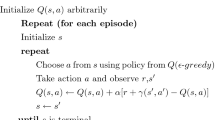Abstract
Residential HVAC system control has been focused on thermal comfort and energy consumption. Due to the complexity of the dynamic building thermal model, weather conditions and human activities, traditional methods such as rule-based control (RBC) and model predictive control (MPC) are difficult to learn a strategy that can save energy while satisfying occupants’ thermal comfort requirements. To solve the above problem, we propose a method combining a thermal comfort prediction model and reinforcement learning to optimize residential multi-zone HVAC control. In this paper, we first design a hybrid model of Support Vector Regression and a Deep Neural Network (SVR-DNN) to predict thermal comfort value, which is taken as a part of the state and reward in reinforcement learning. Then we apply reinforcement learning algorithms (Q-learning, Deep Q-Network (DQN) and Deep Deterministic Policy Gradient (DDPG)) to respectively generate an optimal HVAC control strategy to maintain the stability of thermal comfort and minimize energy consumption. The experimental results show that our SVR-DNN model can improve thermal comfort prediction performance by \(20.5\%\) compared with the deep neural network (DNN); compared with rule-based control, DDPG, DQN and Q-learning based on SVR-DNN can reduce energy consumption by \(11.89\%\), \(8.41\%\), \(6.51\%\) and reduce thermal comfort violation by \(91.8\%\), \(43.2\%\), \(25.4\%\).
This work was financially supported by Primary Research and Development Plan of China (No. 2020YFC2006602), National Natural Science Foundation of China (No. 62072324, No. 61876217, No. 61876121, No. 61772357), University Natural Science Foundation of Jiangsu Province (No. 21KJA520005), Primary Research and Development Plan of Jiangsu Province (No. BE2020026), Natural Science Foundation of Jiangsu Province (No. BK20190942).
The code and data are available at https://github.com/DZKK1234/Multi-zone-residential-HVAC-control.git.
Access this chapter
Tax calculation will be finalised at checkout
Purchases are for personal use only
Similar content being viewed by others
References
Pérez-Lombard, L., Ortiz, J., Pout, C.: A review on buildings energy consumption information. Energy Build. 40(3), 394–398 (2008). https://doi.org/10.1016/j.enbuild.2007.03.007
Shepherd, A., Batty, W.: Fuzzy control strategies to provide cost and energy efficient high quality indoor environments in buildings with high occupant densities. Build. Serv. Eng. Res. Technol. 24(1), 35–45 (2003)
Qiu, S., Li, Z., Li, Z., Li, J., Long, S., Li, X.: Model-free control method based on reinforcement learning for building cooling water systems: Validation by measured data-based simulation. Energy Build. 218, 110055 (2020). https://doi.org/10.1016/j.enbuild.2020.110055
Brandi, S., Piscitelli, M.S., Martellacci, M., Capozzoli, A.: Deep reinforcement learning to optimise indoor temperature control and heating energy consumption in buildings. Energy Build. 224, 110225 (2020)
Jiang, Z., et al.: Building HVAC control with reinforcement learning for reduction of energy cost and demand charge. Energy Build. 239, 110833 (2021)
Shaw, E.W.: Thermal comfort: analysis and applications in environmental engineering, by p. o. fanger. 244 pp. danish technical press. copenhagen, denmark, 1970. danish kr. 76, 50. J. Roy. Soc. Promot. Health (1972)
Zhou, X., et al.: Data-driven thermal comfort model via support vector machine algorithms: insights from ashrae rp-884 database. Energy Build. 211, 109795 (2020). https://doi.org/10.1016/j.enbuild.2020.109795
Liu, W., Lian, Z., Zhao, B.: A neural network evaluation model for individual thermal comfort. Energy Build. 39(10), 1115–1122 (2007)
Wei, T., Zhu, Q., Maasoumy, M.: Co-scheduling of HVAC control, EV charging and battery usage for building energy efficiency. In: Chang, Y. (ed.) The IEEE/ACM International Conference on Computer-Aided Design, ICCAD 2014, San Jose, CA, USA, November 3–6, 2014, pp. 191–196. IEEE (2014)
Zenger, A., Schmidt, J., Krödel, M.: Towards the intelligent home: using reinforcement-learning for optimal heating control. In: Timm, I.J., Thimm, M. (eds.) KI 2013. LNCS (LNAI), vol. 8077, pp. 304–307. Springer, Heidelberg (2013). https://doi.org/10.1007/978-3-642-40942-4_30
Du, Y., et al.: Intelligent multi-zone residential HVAC control strategy based on deep reinforcement learning. Appl. Energy 281, 116117 (2021)
Deng, J., Yao, R., Yu, W., Zhang, Q., Li, B.: Effectiveness of the thermal mass of external walls on residential buildings for part-time part-space heating and cooling using the state-space method. Energy Build. 190, 155–171 (2019). https://doi.org/10.1016/j.enbuild.2019.02.029
Bureau, C.M., et al.: China Standard Weather Data for Analyzing Building Thermal Conditions, pp. 90–105. China Building Industry Publishing House, Beijing (2005)
Földváry Ličina, V., et al.: Development of the ashrae global thermal comfort database II. Build. Environ. 142, 502–512 (2018). https://doi.org/10.1016/j.buildenv.2018.06.022
Author information
Authors and Affiliations
Corresponding authors
Editor information
Editors and Affiliations
Rights and permissions
Copyright information
© 2022 Springer Nature Switzerland AG
About this paper
Cite this paper
Ding, Z., Fu, Q., Chen, J., Wu, H., Lu, Y., Hu, F. (2022). Multi-zone Residential HVAC Control with Satisfying Occupants’ Thermal Comfort Requirements and Saving Energy via Reinforcement Learning. In: Shen, H., et al. Parallel and Distributed Computing, Applications and Technologies. PDCAT 2021. Lecture Notes in Computer Science(), vol 13148. Springer, Cham. https://doi.org/10.1007/978-3-030-96772-7_40
Download citation
DOI: https://doi.org/10.1007/978-3-030-96772-7_40
Published:
Publisher Name: Springer, Cham
Print ISBN: 978-3-030-96771-0
Online ISBN: 978-3-030-96772-7
eBook Packages: Computer ScienceComputer Science (R0)




